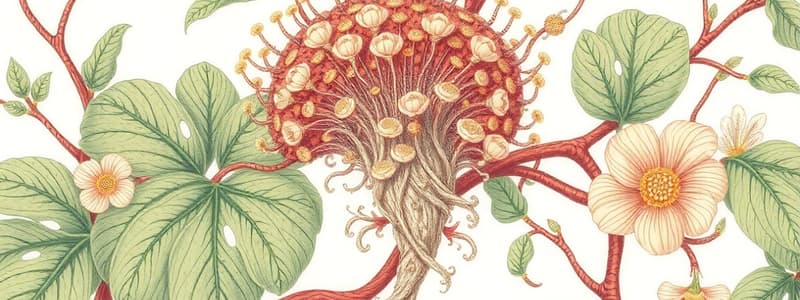Podcast
Questions and Answers
What type of organism is Phytophthora infestans?
What type of organism is Phytophthora infestans?
- Primary decomposer
- Strict pathogen only
- Facultative saprophyte (correct)
- Obligate saprophyte only
Which of the following is true regarding conidia?
Which of the following is true regarding conidia?
- They germinate only through stomata.
- They can germinate both directly and indirectly. (correct)
- They only reproduce in the absence of moisture.
- They can only develop directly into zoospores.
During the vegetative cycle, where do conidiophores emerge from?
During the vegetative cycle, where do conidiophores emerge from?
- From mature shoots
- Directly from the tubers
- Through the stomata (correct)
- From root structures
What structure helps in the mating process of Phytophthora infestans?
What structure helps in the mating process of Phytophthora infestans?
What is the characteristic feature of the antheridium in Phytophthora infestans?
What is the characteristic feature of the antheridium in Phytophthora infestans?
What controls the sexual cycle mating in this organism?
What controls the sexual cycle mating in this organism?
Which of the following statements about the organism's reproduction is true?
Which of the following statements about the organism's reproduction is true?
Where is the antheridium located in relation to the oogonium?
Where is the antheridium located in relation to the oogonium?
What is the shape description of the antheridium?
What is the shape description of the antheridium?
How does the oogonium interact with the antheridium?
How does the oogonium interact with the antheridium?
Flashcards
Phytophthora infestans
Phytophthora infestans
A type of fungus that causes "Late Blight of Potato and Tomato". It can survive as a decomposer or a parasite, meaning it can obtain food from dead organic matter or live organisms.
Mycelium
Mycelium
A network of branching filaments that make up the body of a fungus. In Phytophthora infestans, the mycelium produces conidiophores that emerge through the stomata of the host plant.
Conidiophores
Conidiophores
Reproductive structures that produce conidia, which are asexual spores. They are produced by the mycelium and emerge through the stomata of the host plant.
Conidia
Conidia
Signup and view all the flashcards
Sexual Cycle
Sexual Cycle
Signup and view all the flashcards
Compatibility factor in sexual cycle mating
Compatibility factor in sexual cycle mating
Signup and view all the flashcards
Heterothallic
Heterothallic
Signup and view all the flashcards
Facultative homothallic
Facultative homothallic
Signup and view all the flashcards
Antheridium
Antheridium
Signup and view all the flashcards
Oogonium
Oogonium
Signup and view all the flashcards


